Table of Contents
ToggleClass 10 maths 13.1 NCERT solutions
NCERT Solutions For Class 10 Maths Chapter 13 Statistic Ex -13.1
Download the free NCERT Maths Chapter 13 Solutions for Class 10 here Statistic in Maths Class 10 NCERT Solutions are a great resource for homework assistance. For class 10 maths 13.1 NCERT solutions Expert Bhautikstudy.com Teachers developed the NCERT Solutions. Complete solutions to all the problems in NCERT Textbook’s Chapter 12 Math Class 10 Triangles Exercise 13.1.
Class 10 Maths 13.1 NCERT Solutions Question 1.
1. A survey was conducted by a group of students as a part of their environment awareness program, in which they collected the following data regarding the number of plants in 20 houses in a locality. Find the mean number of plants per house.
| Number of Plants | 0-2 | 2-4 | 4-6 | 6-8 | 8-10 | 10-12 | 12-14 |
| Number of Houses | 1 | 2 | 1 | 5 | 6 | 2 | 3 |
Which method did you use for finding the mean, and why?
Solution:

Class 10 Maths 13.1 NCERT Solutions Question 2.
2. Consider the following distribution of daily wages of 50 workers of a factory.
| Daily wages (in Rs.) | 500-520 | 520-540 | 540-560 | 560-580 | 580-600 |
| Number of workers | 12 | 14 | 8 | 6 | 10 |
Find the mean daily wages of the workers of the factory by using an appropriate method.
Solution:
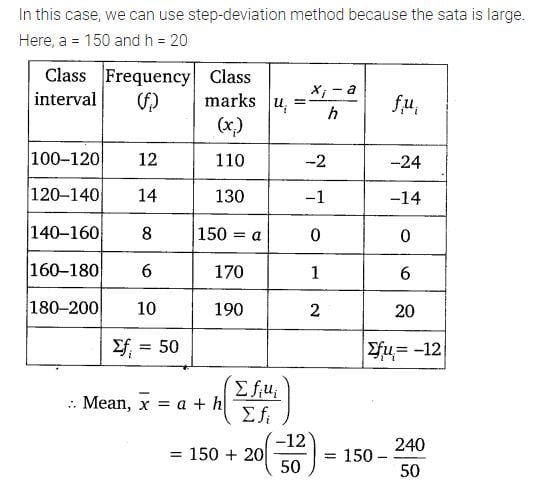
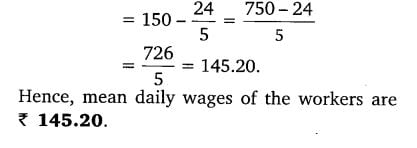
Class 10 Maths 13.1 NCERT Solutions Question 3.
3. The following distribution shows the daily pocket allowance of children of a locality. The mean pocket allowance is Rs 18. Find the missing frequency f.
| Daily Pocket Allowance(in c) | 11-13 | 13-15 | 15-17 | 17-19 | 19-21 | 21-23 | 23-35 |
| Number of children | 7 | 6 | 9 | 13 | f | 5 | 4 |
Solution:
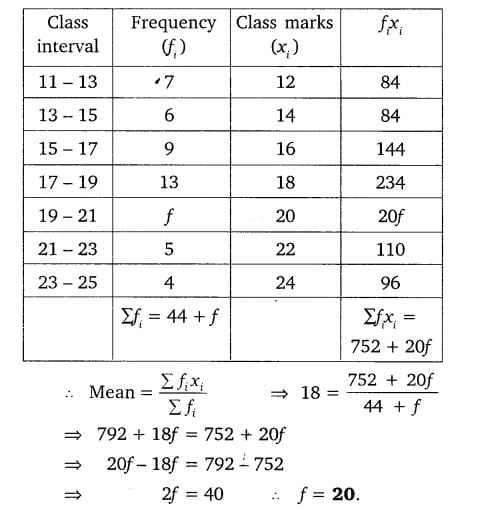
Class 10 Maths 13.1 NCERT Solutions Question 4.
4. Thirty women were examined in a hospital by a doctor, and the number of heartbeats per minute were recorded and summarised as follows. Find the mean heartbeats per minute for these women, choosing a suitable method.
| Number of heart beats per minute | 65-68 | 68-71 | 71-74 | 74-77 | 77-80 | 80-83 | 83-86 |
| Number of women | 2 | 4 | 3 | 8 | 7 | 4 | 2 |
Solution:
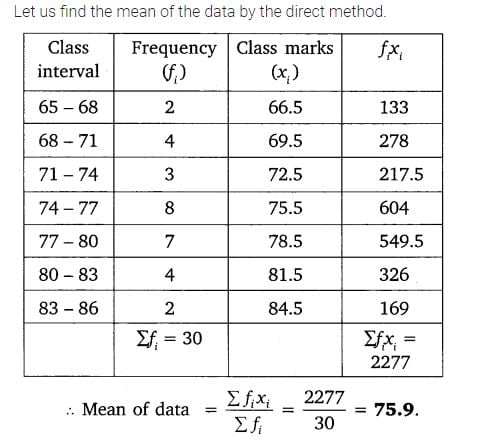
Class 10 Maths 13.1 NCERT Solutions Question 5.
5. In a retail market, fruit vendors were selling mangoes kept in packing boxes. These boxes contained varying number of mangoes. The following was the distribution of mangoes according to the number of boxes.
| Number of mangoes | 50-52 | 53-55 | 56-58 | 59-61 | 62-64 |
| Number of boxes | 15 | 110 | 135 | 115 | 25 |
Find the mean number of mangoes kept in a packing box. Which method of finding the mean did you choose?
Solution:
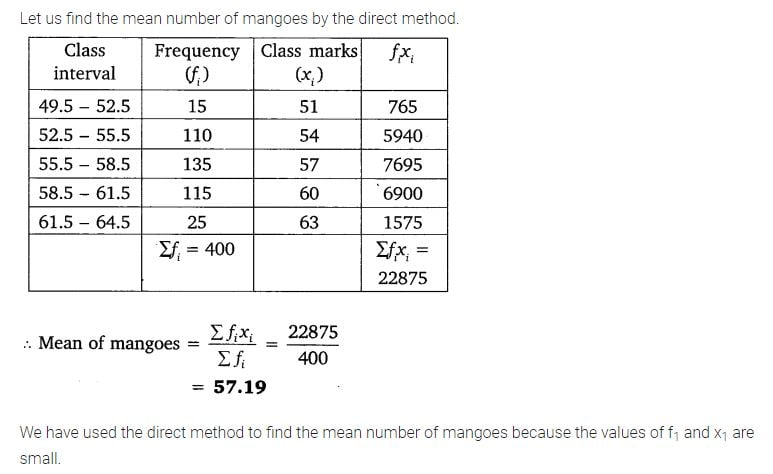
Class 10 Maths 13.1 NCERT Solutions Question 6.
6. The table below shows the daily expenditure on food of 25 households in a locality.
| Daily expenditure(in c) | 100-150 | 150-200 | 200-250 | 250-300 | 300-350 |
| Number of households | 4 | 5 | 12 | 2 | 2 |
Find the mean daily expenditure on food by a suitable method.
Solution:
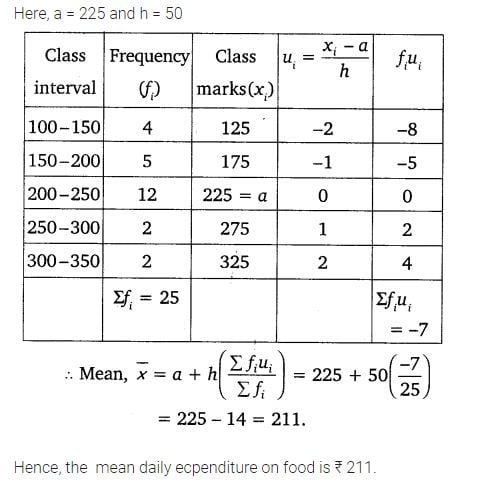
Class 10 Maths 13.1 NCERT Solutions Question 7.
7. To find out the concentration of SO2 in the air (in parts per million, i.e., ppm), the data was collected for 30 localities in a certain city and is presented below:
| Concentration of SO2 ( in ppm) | Frequency |
| 0.00 – 0.04 | 4 |
| 0.04 – 0.08 | 9 |
| 0.08 – 0.12 | 9 |
| 0.12 – 0.16 | 2 |
| 0.16 – 0.20 | 4 |
| 0.20 – 0.24 | 2 |
Find the mean concentration of SO2 in the air.
Solution:

Class 10 Maths 13.1 NCERT Solutions Question 8.
8. A class teacher has the following absentee record of 40 students of a class for the whole term. Find the mean number of days a student was absent.
| Number of days | 0-6 | 6-10 | 10-14 | 14-20 | 20-28 | 28-38 | 38-40 |
| Number of students | 11 | 10 | 7 | 4 | 4 | 3 | 1 |
Solution:
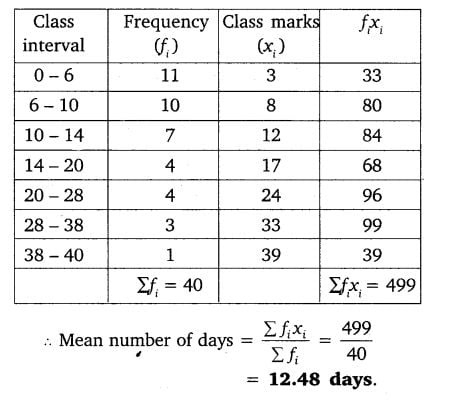
Class 10 Maths 13.1 NCERT Solutions Question 9.
9. The following table gives the literacy rate (in percentage) of 35 cities. Find the mean literacy rate.
| Literacy rate (in %) | 45-55 | 55-65 | 65-75 | 75-85 | 85-98 |
| Number of cities | 3 | 10 | 11 | 8 | 3 |
Solution:
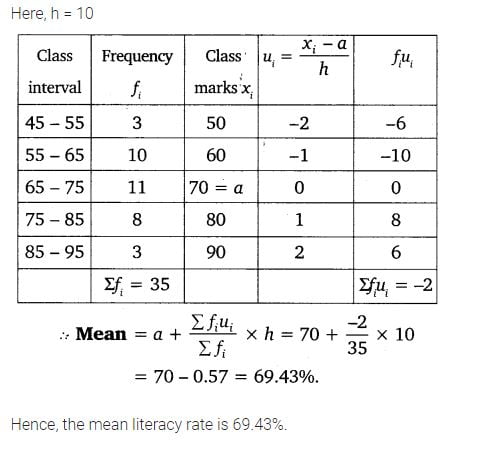
Maths in Class 10: Statistics
In Class 10 Maths 13.1 NCERT Solutions Students will talk about patterns in terms that come after those that come after by adding a certain number to the terms that came before in this chapter. Additionally, they see how to calculate the sum of n successive terms and the nth term. When students tackle real-world situations, they will successfully understand Statistics.
As a result, these NCERT Solutions for Class 10 Maths will aid students in comprehending various question formats and their responses, in addition to providing important shortcuts and diagrammatic explanations. The Class 10 Maths Chapter 13 PDF NCERT Solutions are all provided in easy-to-understand manner. Students who fully understand these solutions will be able to solve challenging situations with ease.
The teachers have carefully selected the Class 10 NCERT Solutions to help students become more adept at solving problems. Students can consult Bhautik study materials for Surface areas and volumes for a clearer understanding.
Statistics, Chapter 13 of Class 10 Maths, is one of the most significant sections in the textbook. This chapter is worth between 11 and 12 points on the CBSE test. This chapter will likely include three questions on average, with marks awarded in the format of 3+4+4 (depending on the question).
What is the Advantage of Class 10 Maths Class 10 Maths 13.1 NCERT Solutions Provided by Bhautik Study?
Class 10 Maths 13.1 NCERT Solutions uses a number of important components.
It offers answers to all of the exercises’ problems from the NCERT Maths textbook for Class 10.
Make a practice of asking challenging questions to help you demonstrate your understanding of the subjects.
It includes the most recent CBSE syllabus broken down by terms as well as key categories of questions that will be asked throughout the test.
It is quite useful for practicing essential drawings.
helps you to retain key math techniques and formulas.
NCERT Answers, NCERT We supply all of the examples, notes, textbooks, videos, and animations for all of the classes and disciplines. In order to comprehend significant problem kinds from an examination perspective, students can also obtain additional study materials from the CBSE Board.
class 10 maths 13.1 ncert solutions –
Students hoping to do well in this chapter can access the NCERT solutions for Class 10 Maths Chapter 14: Statistics. With the help of these NCERT Solutions, which clearly explain the methods and procedures for solving the questions, students may easily and rapidly grasp the principles.
The world is very data-oriented; in fact, a set of data representing pertinent information exists in every field. The area of mathematics known as statistics is concerned with the meaningful representation of data.
You will come across numerous real-world situations where a set of data is represented in tabular form, graphs, or pie charts using the principles of statistics. This chapter will cover a variety of techniques, including how to discover the mode and median of grouped data, convert frequency distribution, and understand the relationship between mode, mean, and median techniques. The greatest study guides for the CBSE exam are the 10th Class NCERT solutions.
Important Elements of the NCERT Solutions for Math Class 10 Chapter 13: Statistics
-Students can use the solutions for the statistics chapter as a guide.
-Students will find it useful to compare their scores to the questions posed by this chapter.
-Using this resource, students can get ready for and complete the revision for Chapter 13.
-Statistics specialists have provided answers to the questions.
-The information is in line with the recommendations of the CBSE Syllabus (2024–25).
Using the various resources offered by Bhautik Study, statistics can also be comprehended more successfully. The solutions are designed to aid pupils in achieving high scores on the CBSE examinations.